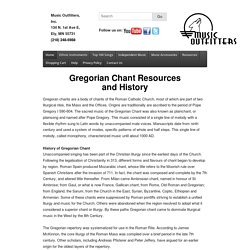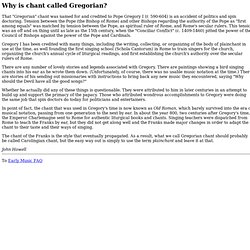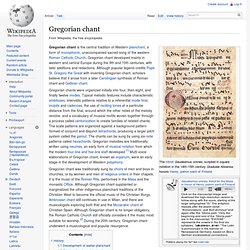

Gregorian Chant, 1965: Choir of the Abbey of Mount Angel, Dom David Nicholson, OSB. Gregorian chant - Deum verum. Gregorian Chant Resources and History. Gregoran chants are a body of chants of the Roman Catholic Church, most of which are part of two liturgical rites, the Mass and the Offices.

Origins are traditionally are ascribed to the period of Pope Gregory I 590-604. The sacred music of the Gregorian Chant was also known as plainchant, or plainsong and named after Pope Gregory. This music consisted of a single line of melody with a flexible rhythm sung to Latin words by unaccompanied male voices. Manuscripts date from ninth century and used a system of modes, specific patterns of whole and half steps. This single line of melody, called monophony, characterized music until about 1000 AD.
History of Gregorian Chant Unaccompanied singing has been part of the Christian liturgy since the earliest days of the Church. The Gregorian repertory was systematized for use in the Roman Rite. Scholars debate whether the essentials of the melodies originated in Rome, before the 7th century, or in Francia, in the 8th and early 9th centuries. Why is chant called Gregorian? That "Gregorian" chant was named for and credited to Pope Gregory I (r. 590-604) is an accident of politics and spin doctoring.

Tension between the Pope (the Bishop of Rome) and other Bishops regarding the authority of the Pope as "first among equals" was matched by tension between the Pope, as spiritual ruler of Rome, and Rome's secular rulers. This tension was an off and on thing until as late as the 15th century, when the "Conciliar Conflict" (c. 1409-1460) pitted the power of the Council of Bishops against the power of the Pope and Cardinals. Gregory I has been credited with many things, including the writing, collecting, or organizing of the body of plainchant in use at the time, as well founding the first singing school (Schola Cantorum) in Rome to train singers for the church, organizing the church's annual cycle of liturgical readings, and first establishing the church's authority over the secular rulers of Rome.
Whether he actually did any of these things is questionable. Gregorian chant (music. Abbaye de Solesmes - Histoire du Chant Grégorien. Gregorian Chant is a musical repertory made up of chants used in the liturgical services of the Roman Catholic Church.

In fact, the liturgical tradition which the Church has given us is a vocal, monophonic music composed in Latin using sacred texts from the Ancient and New Testaments. This is why Gregorian Chant has often been called a "sung Bible". Linked intimately to the liturgy in this way, the goal of the Gregorian melodies is to favor spiritual growth, reveal the gifts of God and the full coherence of the Christian message. What we call Gregorian chant today first appears distinctly in the Roman repertory of the fifth and sixth centuries. Its implimentation and perhaps some of its composition was in the hands of a group of ministers in a service specially dedicated to the Roman basilicas, the schola cantorum. The texts (words and some musical notations), committed to writing in books, become at this time an official reference text. Gregorian Chant Notation. Gregorian Chants Online. Gregorian chant.
Gregorian chant is the central tradition of Western plainchant, a form of monophonic, unaccompanied sacred song of the western Roman Catholic Church.

Gregorian chant developed mainly in western and central Europe during the 9th and 10th centuries, with later additions and redactions. Although popular legend credits Pope St. Gregory the Great with inventing Gregorian chant, scholars believe that it arose from a later Carolingian synthesis of Roman chant and Gallican chant. History[edit] Development of earlier plainchant[edit] Musical elements that would later be used in the Roman Rite began to appear in the 3rd century. Scholars are still debating how plainchant developed during the 5th through the 9th centuries, as information from this period is scarce. John the Deacon, biographer (c. 872) of Pope Gregory I, modestly claimed that the saint "compiled a patchwork antiphonary",[11] unsurprisingly, given his considerable work with liturgical development.
Origins of mature plainchant[edit]